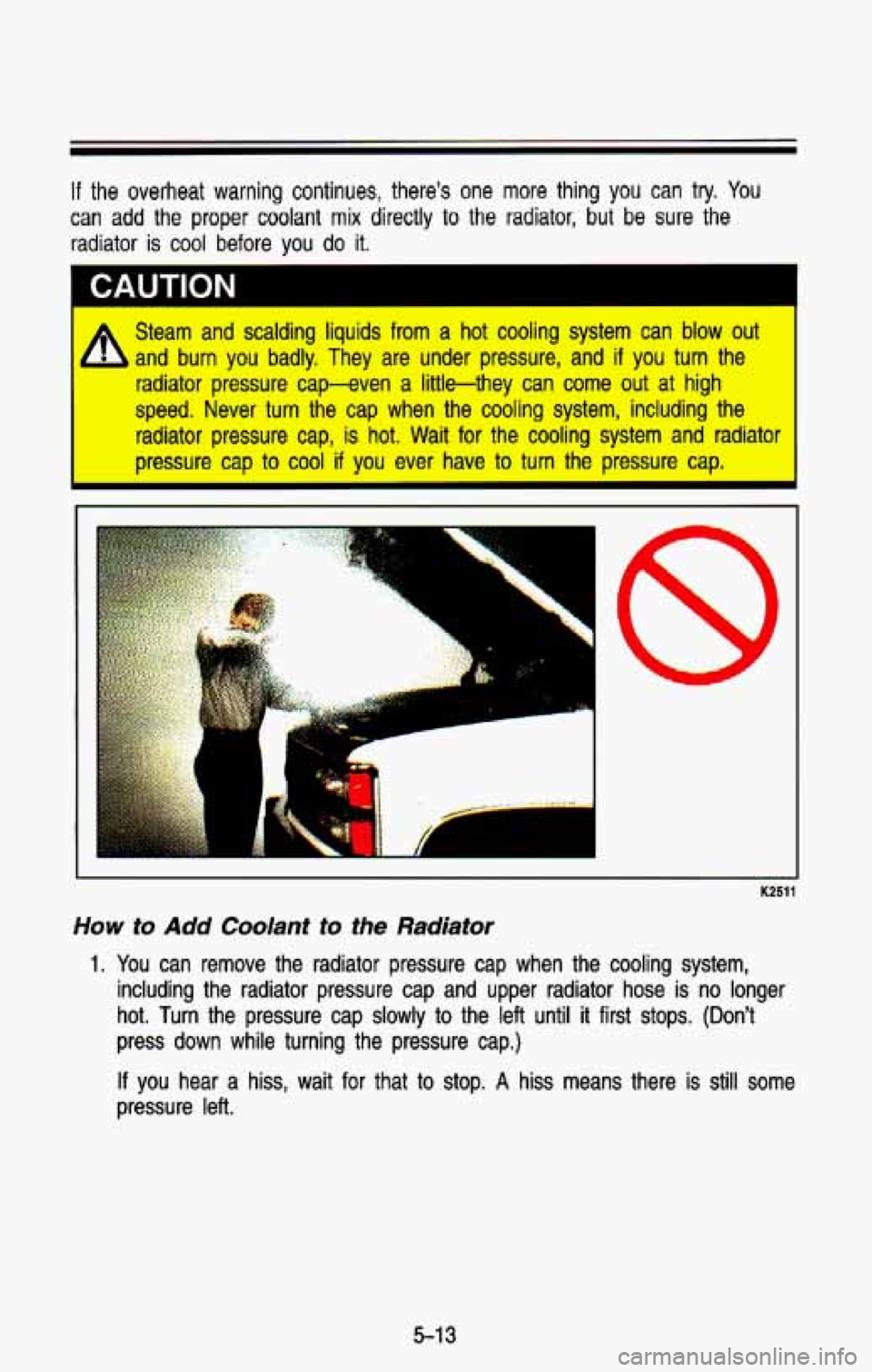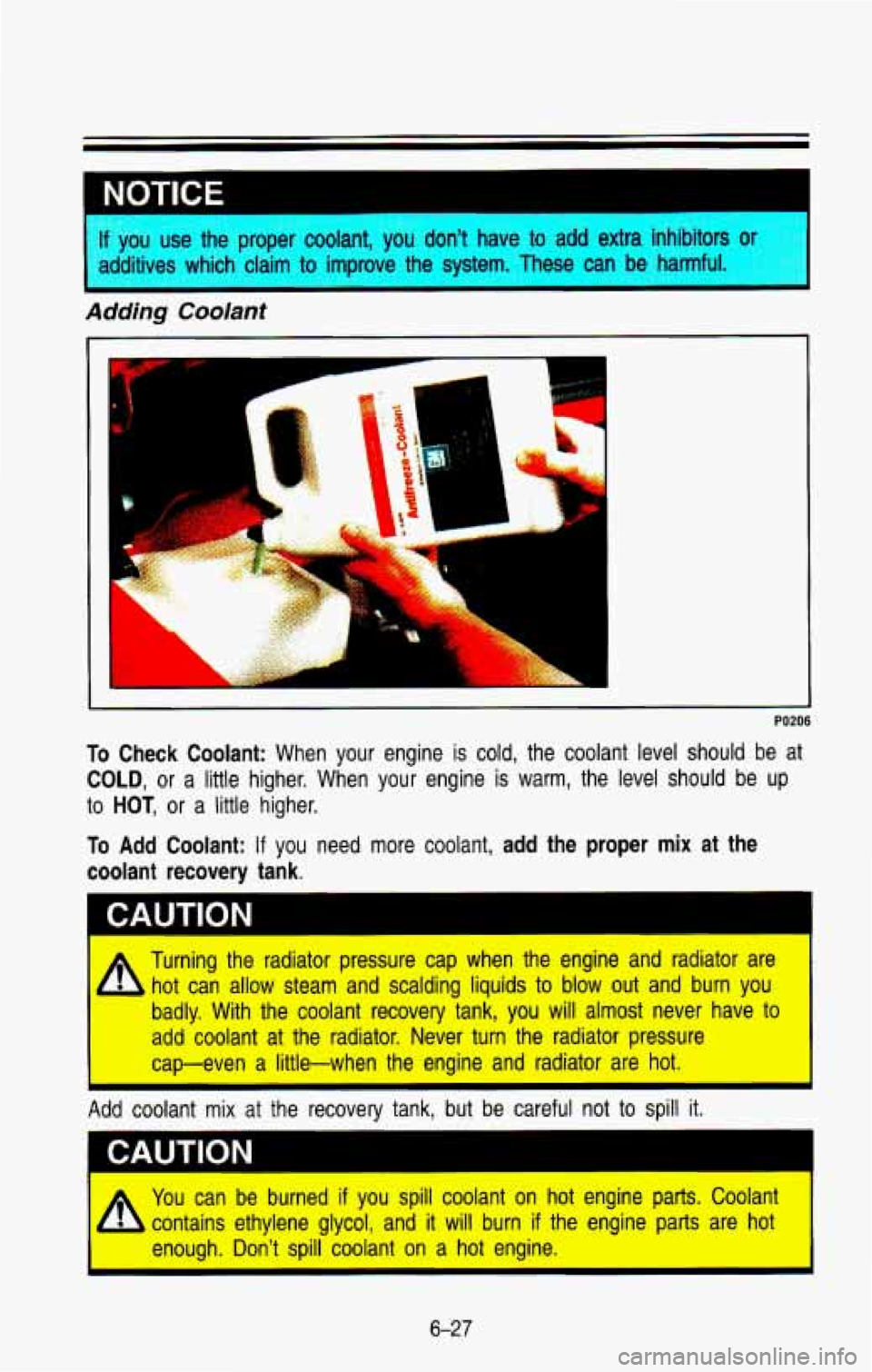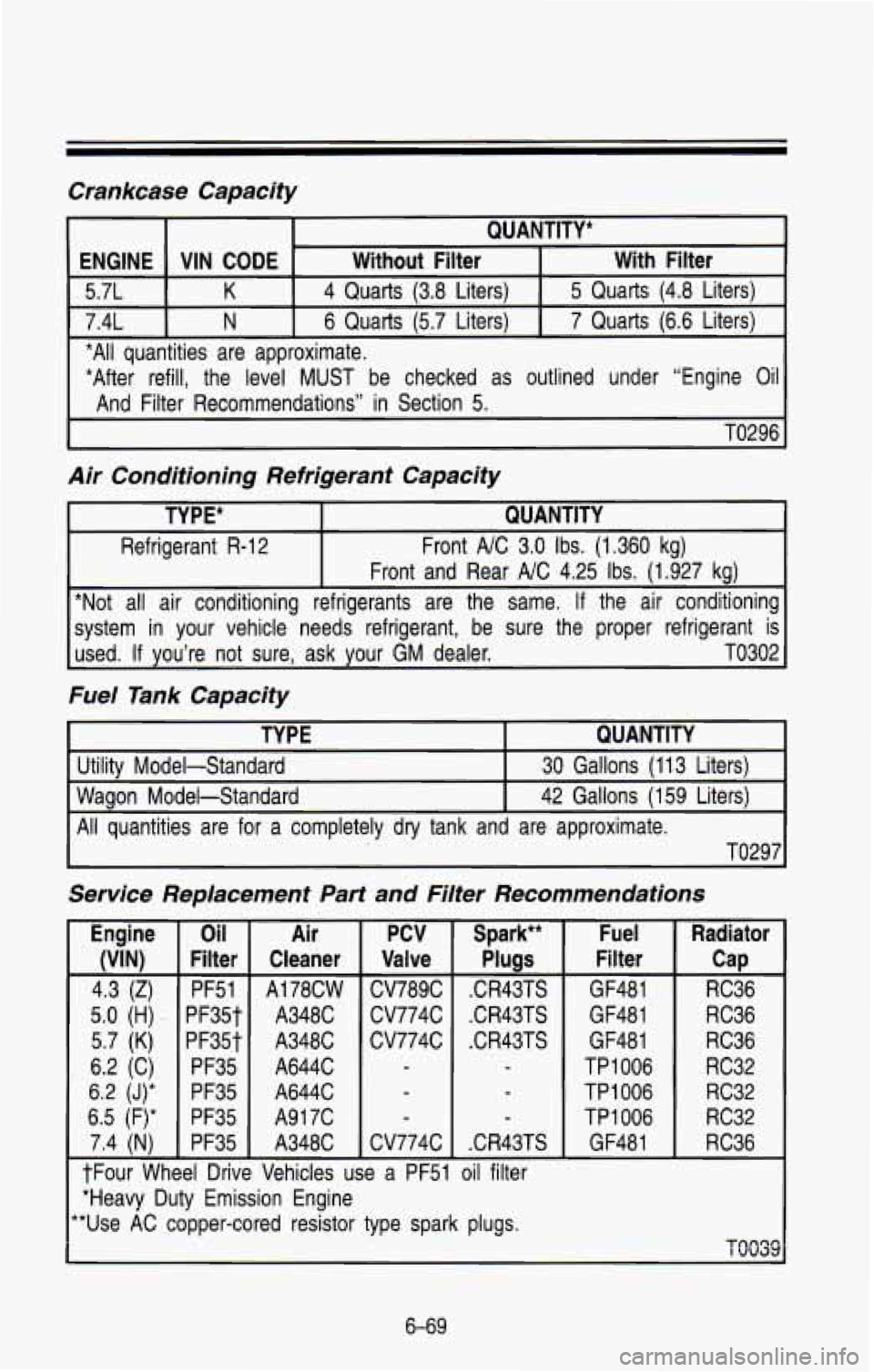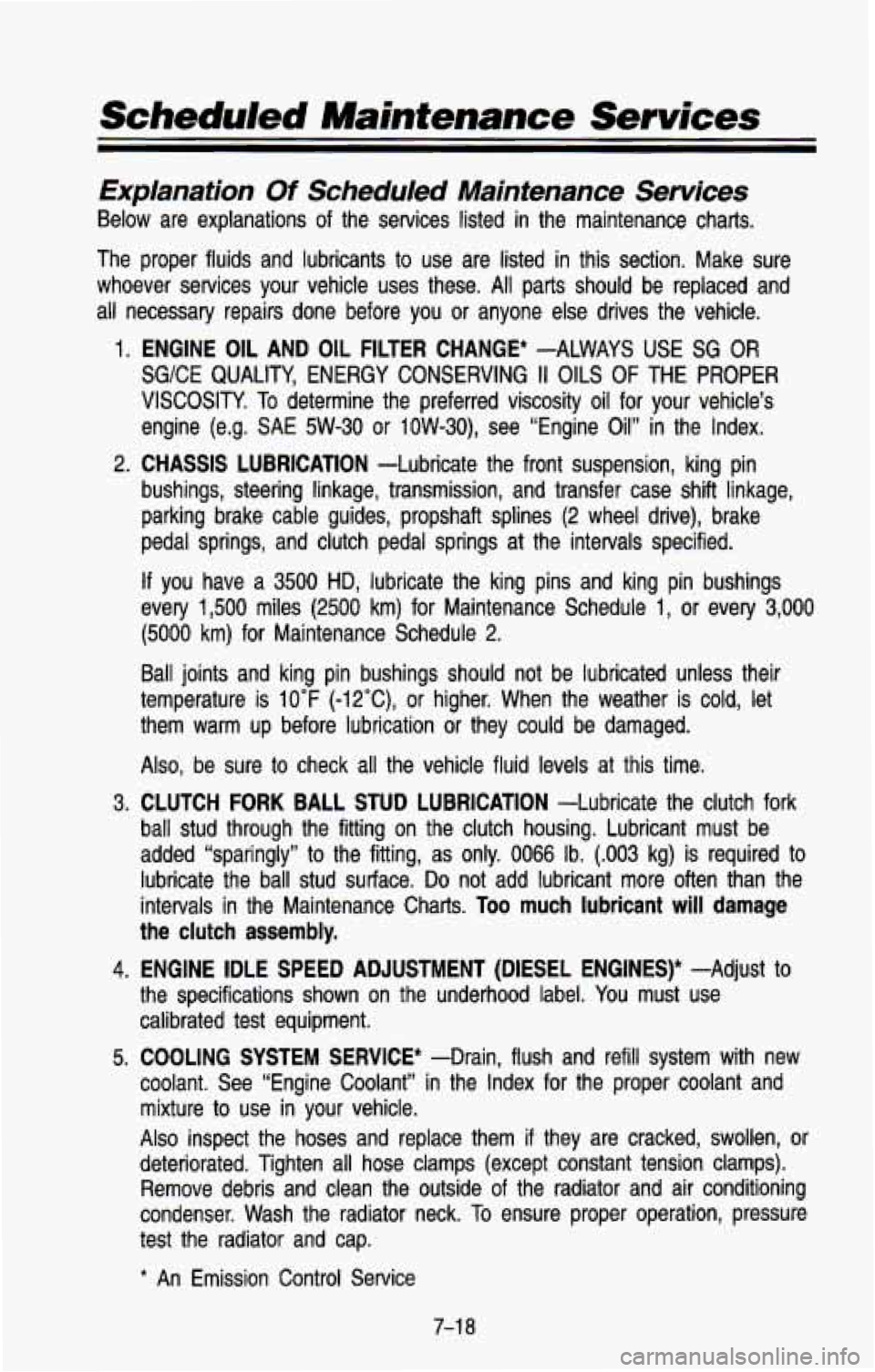Page 241 of 386
Cooling System
.i
I
PO21 0
When you decide it's safe to lift the hood, here's what you'l\
l see:
A. Coolant recovery tank
B. Radiator pressure cap
C. Engine fan
A
An electric fan under the hood can start up even when the engine is
not running and can injure you. Keep hands, clothing, and tools
away from any underhood
electric fan.
CAUTION
If the coolant inside the coolant recovery tank or surge tank is \
boiling, don't
do anything else until it cools down.
5-1 0
Page 244 of 386

If the overheat warning continues, there's one more thing you can try. You
can add the proper coolant mix directly to the radiator, but be sure the
radiator is cool before you
do it.
I CAUTION
4 Steam and scalding liquids from a hot cooling system can blow out
- and burn you badly. They are under pressure, and if you turn the
radiator
pressure capeven a little-they can come out at high
speed. Never turn the cap when the cooling system, Including the
radiator pressure cap, is hat. Wait for the cooling system and radiato
pressure cap to cool if you ever have to turn the pressure cap.
I
8
K2511
How to Add Coolant to the Radiator
1. You can remove the radiator pressure cap when the cooling system,
including the radiator pressure cap and upper radiator hose is no longer
hot. Turn the pressure cap
slowly to the left until it first stops. (Don't
press down while turning the pressure cap.)
If you hear a hiss, wait for that to stop. A hiss means there is still some
pressure left.
5-1 3
Page 245 of 386
PO244
2. Then keep turning the pressure cap, but now push down as you turn it.
Remove the pressure cap.
L
K2341
3. Fill the radiator with the proper mix, up to the base of the filler neck.
4. Then fill the coolant recovery tank to COLD.
5. Put the cap back on the coolant recovery tank, but leave the radi\
ator
pressure
cap off.
5-1 4
Page 246 of 386
K2550
6. Start the engine and let it run until you can feel the upper radiator hose
getting hot. Watch out for the engine fan@).
7. By this time, the coolant level inside the radiator filler neck m\
ay be
lower.
If the level is lower, add more of the proper mix through the filler
neck until the level reaches the base
of the filler neck.
1
K2515
8. Then replace the pressure cap. Be sure the arrows on the pressure cap
line up like this.
5-1 5
Page 292 of 386

k
NOTICE
f YOU use the proper coolant, you don’t have to add extra inhibitors or
idditives which claim to improve the system. These can be harmful
Adding Coolant
‘1 L
L
L
PO206
To Check Coolant: When your engine is cold, the coolant level should be at
COLD, or a little higher. When your engine is warm, the level shoul\
d be up
to HOT, or a little higher.
To Add Coolant: If you need more coolant, add the proper mix at the
coolant recovery tank.
I CAUTION
4
Turning the radiator pressure cap when the engine and radiator are
hot can allow steam and scalding liquids to blow out and burn you
badly. With the coolant recovery tank, you will almost never have to
add coolant at the radiator. Never turn the radiator pressure
I cap-even a little-when the engine and radiator are hot. I
Add coolant mix at the recovery tank, but be careful not to spill it.
~ ~~
1 CAUTION I
You can be burned if you spill coolant on hot engine parts. Coolant
- b contains ethylene glycol, and it will burn if the engine parts are hot
I enough. Don’t spill coolant on a hot engine. I
6-27
Page 293 of 386
Service & Appearance Care
Radiator Pressure Cap
I
I
-
- K2515
1 NOTICE
four radiator pressure cap is a 15 psi (105 kPa) pressure-type cap and
nust be tightly installed to prevent coolant loss and possible engine
mage from overheating. Be sure the arrows on the cap line up \
with
werffow tube
on the radiator filler neck.
-m recommended.
I
Thermostat
Engine coolant temperature is controlled by a thermostat in the engine coolant
system. The thermostat stops the
flow of coolant through the radiator until the
coolant reaches a preset temperature.
When you replace
your thermostat, an AC@ thermostat is recommended.
6-28
Page 334 of 386

Crankcase Capacify
QUANTITY*
ENGINE VIN CODE Without Filter With Filter
5.7L K 4 Quarts (3.8 Liters) 5 Quarts (4.8 Liters)
7.4L N 6 Quarts (5.7 Liters) 7 Quarts (6.6 Liters)
*All quantities are approximate.
*After refill, the level MUST be checked as outlined under “\
Engine Oil
TO296
And Filter Recommendations” in Section
5.
Air Condifioning Refrigeranf Capacify
TYPE* QUANTITY
Refrigerant R-12 Front
AJC 3.0 Ibs. (1.360 kg)
Front and Rear AJC 4.25 Ibs. (1.927 kg)
*Not all air conditioning refrigerants are the same.
If the air conditioning
system in your vehicle needs refrigerant, be sure the proper r\
efrigerant is
used. If you’re not sure, ask your GM dealer. TO302
Fuel Tank Capacify
I -1
Utility Model-Standard 30 Gallons (113 Liters)
Wagon Model-Standard 42 Gallons (159 Liters)
All quantities are for a completely dry tank and are approxima\
te. TO2971
Service Replacemenf Part and Filfer Recommendations
5.7 (K)
6.2 (C)
6.2
(J)*
6.5 (F)*
-
Oil
Filter
PF5 1
PF35t PF35t
PF35
PF35
PF35
PF35
-
1
Air PCV
Cleaner Valve
A348C
cv774c
A348C cv774c
A644C
A644C
A91 7C
A348C cv774c
AI 7acw cv7agc
Spark**
Plugs
.CR43TS
.CR43TS
.CR43TS
-
.CR43TS i
use a PF51 oil filter
*Heavy Duty Emission Engine
**Use
AC copper-cored resistor type spark plugs.
Fuel
Filter
GF481
GF481
GF481
TP
1 006
TP 1 006
TP 1 006 G F48 1
Radiator
RC36
RC36
RC36
RC32
RC32
RC32
RC36
Cap
6-69
Page 355 of 386

Scheduled Maintenance Services
Explanation Of Scheduled Maintenance Services
Below are explanations of the services listed in the maintenance charts.
The proper fluids and lubricants to use are listed in this section. Make sure
whoever services your vehicle uses these.
All parts should be replaced and
all necessary repairs done before you or anyone else drives the ve\
hicle.
1. ENGINE OIL AND OIL FILTER CHANGE* -ALWAYS USE SG OR
SG/CE QUALITY, ENERGY CONSERVING II OILS OF THE PROPER
VISCOSITY. To determine the preferred viscosity oil for your vehicle’s
engine (e.g. SAE 5W-30 or
10W-30), see “Engine Oil” in the Index.
2. CHASSIS LUBRICATION -Lubricate the front suspension, king pin
bushings, steering linkage, transmission, and transfer case shift\
linkage,
parking brake cable guides, propshaft splines
(2 wheel drive), brake
pedal springs, and clutch pedal springs at the intervals specif\
ied.
If you have a 3500 HD, lubricate the king pins and king pin bushings
every
1,500 miles (2500 km) for Maintenance Schedule 1, or every 3,000
(5000 km) for Maintenance Schedule 2.
Ball joints and king pin bushings should not be lubricated unl\
ess their
temperature is
10°F (-12”C), or higher. When the weather is cold, let
them warm up before lubrication
or they could be damaged.
Also, be sure to check all the vehicle fluid levels at this time.
3.
CLUTCH FORK BALL STUD LUBRICATION -Lubricate the clutch fork
ball stud through the fitting on the clutch housing. Lubricant \
must be
added “sparingly” to the fitting, as only.
0066 Ib. (.003 kg) is required to
lubricate the ball stud surface. Do not add lubricant more often than the
intervals in the Maintenance Charts.
Too much lubricant will damage
the clutch
assembly.
4. ENGINE IDLE SPEED ADJUSTMENT (DIESEL ENGINES)* -Adjust to
the specifications shown on the underhood label. You must use
calibrated test equipment.
5. COOLING SYSTEM SERVICE* -Drain, flush and refill system with new
coolant. See “Engine Coolant” in the Index for the proper\
coolant and
mixture
to use in your vehicle.
Also inspect the hoses and replace them if they i cracked, swollen, or
deteriorated. Tighten all hose clamps (except consrant tension clamps).
Remove debris and clean the outside of the radiator and air c\
onditioning
condenser. Wash the radiator neck.
To ensure proper operation, pressure
test the radiator and cap.
* An Emission Control Service
7-1 8